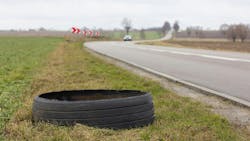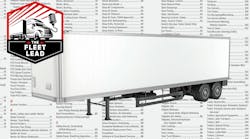How market shifts in truck tire supply are impacting fleet maintenance costs
Key takeaways
- Smaller tire dealers are disappearing, leaving fleets with fewer service options and rising maintenance risks.
- Tier 3 and Tier 4 tires are gaining traction as fleets seek lower costs, but service quality may decline.
- Dealer consolidation could push skilled technicians to larger companies, widening the gap in service reliability.
Summer has traditionally been the busiest time for the commercial truck tire service industry. Between construction restarts, retailers stocking up for the upcoming holiday season, and the hot weather that leads to an increase in underinflated tire failure, the June to August period is typically the busiest time of year. Reports from the field indicate that 2025 is going in a different direction.
Uncertainty is kryptonite for businesses and financial markets. The current state of affairs in the U.S., Canada, and Mexico is chaotic, with trade imbalances and reciprocal tariffs. Global markets do not fare any better, with the Port of Los Angeles averaging five ships a day rather than the usual 10 or more, according to Bloomberg. There are numerous headwinds facing the transportation industry.
Tire market shifts put pressure on small dealers and fleets
Domestic truck tire manufacturers are also caught in the crosshairs. The major brands are more focused on OEM and national account business, as the smaller fleets turn to Tier 3 and Tier 4 tires to save money. While large carriers continue to emphasize cost per mile when purchasing truck tires and retreads, buyers now have a wide variety of tires to choose from at better price points with improved quality. If this trend continues, the trucking industry will become even more dependent on offshore manufacturing as domestic production adjusts to reduced demand.
Competition is the best tool for controlling prices. In the commercial truck tire service space, smaller dealers keep larger dealers honest by offering fleets alternatives. Based on what I’m hearing, both are in feast or famine mode to some degree, with more business they can handle one day and a total drop-off the next. Dealers on the larger end of the spectrum can more easily weather the storm, while the smaller companies are faced with much tougher decisions when it comes to staffing and payroll. If this trend continues, carriers will have fewer options for truck tires and service.
Low-cost offshore brands will still be available, but the quality of the service will suffer. The best technicians could gravitate away from the smaller dealers to the larger ones with the promise of consistent pay, benefits, and overtime.
It’s still possible to get a Tier 3 or Tier 4 tire with good service, but we could be looking at a future where economy tires are accompanied by economy service. Poorly trained and equipped technicians may not follow industry-recommended practices for servicing truck tires, so fleets should expect reduced performance and more roadside tire failures.
I fear that we are losing the middle. There will always be the pickup truck and compressor crowd that offers bargain-basement prices on the least expensive tires. The fleet usually gets what it pays for in those instances; in many cases, they are not paying for insurance. If that bargain-service provider improperly installs or repairs a tire that results in an accident, the fleet will end up as the primary defendant. Plaintiff attorneys don’t care where the money comes from, so the deep-pocketed carrier becomes the primary target.
The smaller, reputable tire dealers between the mega-dealers and the pickup trucks are the key to maintaining balance in the commercial truck tire market.
They have adequate insurance and offer the broadest range of products and services because they aren’t bound by contracts with the major manufacturers that limit what they can sell. Quality service is often their focus since they have a smaller number of locations and technicians to manage. Many of them are being bought out as aging owners are faced with the challenges of remaining profitable under uncertain market conditions.
Fewer service options could drive up fleet operating costs
There will always be truck-tire service providers to handle the demand for replacement tires. Large, multistate commercial tire dealers have systems in place to ensure that trained and qualified technicians have the service trucks, tools, and equipment they need to keep trucks on the road. They will always be there to keep freight moving safely with tires that are correctly installed, repaired, or retreaded. In addition, they have the assets and insurance to provide an added level of protection for the fleet in the event of an accident.
Feast or famine benefits no one. Tires continue to be a major expense for the trucking industry, and fewer options put even more pressure on maintenance. Operating costs increase when tires are poorly maintained, forcing fleets to choose between higher-priced roadside service and bargain-basement tires with equally low service and no insurance.
About the Author
Kevin Rohlwing
Kevin Rohlwing is the SVP of training for the Tire Industry Association. He has more than 40 years of experience in the tire industry and has created programs to help train more than 180,000 technicians.


